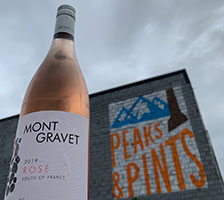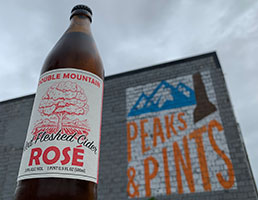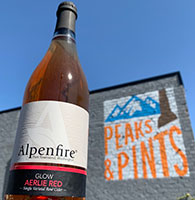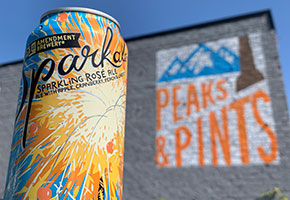 Maybe because it’s a blend, maybe because there’s no point in aging it, or maybe because half-full bottles of it sit wedged into Tacoma refrigerator doors with decorative stoppers jammed in them, but rosé has a dodgy reputation. It’s grocery-store wine. It’s “cougar juice.” It’s simply an embarrassing color. Except, no, it isn’t. Well, get ready for a roséducation. The Greeks and the Romans made rosé. Monks made rosé too. Rosé wines are generally made from red grapes and are very versatile wines. A rosé wine will also be lighter in color than red wine, deeper in color than white wine. The pink color of rosé wine depends on the time the grape skin stays in contact with the juice, also known as maceration. There are also rosé wines that are semi-sparkling or sparkling, with different intensities of sweetness levels and dryness. Drop those ridiculous stereotypes and just #drinkpink. With National Rosé Day only recently being created in 2015, the flourishing “holiday” has excited rosé fans every year on the second Saturday in June. Peaks & Pints paints the mother pink with a to-go flight of rosé wine, rosé cider, and rosé beer that we call Peaks and Pints Pilot Program: Rosé On The Fly.
Maybe because it’s a blend, maybe because there’s no point in aging it, or maybe because half-full bottles of it sit wedged into Tacoma refrigerator doors with decorative stoppers jammed in them, but rosé has a dodgy reputation. It’s grocery-store wine. It’s “cougar juice.” It’s simply an embarrassing color. Except, no, it isn’t. Well, get ready for a roséducation. The Greeks and the Romans made rosé. Monks made rosé too. Rosé wines are generally made from red grapes and are very versatile wines. A rosé wine will also be lighter in color than red wine, deeper in color than white wine. The pink color of rosé wine depends on the time the grape skin stays in contact with the juice, also known as maceration. There are also rosé wines that are semi-sparkling or sparkling, with different intensities of sweetness levels and dryness. Drop those ridiculous stereotypes and just #drinkpink. With National Rosé Day only recently being created in 2015, the flourishing “holiday” has excited rosé fans every year on the second Saturday in June. Peaks & Pints paints the mother pink with a to-go flight of rosé wine, rosé cider, and rosé beer that we call Peaks and Pints Pilot Program: Rosé On The Fly.
Peaks and Pints Pilot Program: Rosé On The Fly
 Mont Gravet Rosé
Mont Gravet Rosé
11.75% ABV
If you’re going to dive into rosé, you might as well go French. Provence, France, is the heart of Rosé country, where making blush wines has not only been a profession, but an art, for generations. Mont Gravet Rosé comes from specially selected Cinsault vineyards in the Languedoc region, located near the warm Mediterranean shoreline in Southern France. The Cinsault variety is also one of the main varietals used in the production of Provence rosé and some of the best reds of the Southern Rhone Valley. Rosé wine is not a varietal. It is made from lightly extracted red grapes, including — but not limited to — Grenache, Syrah, Cinsault, and Pinot Noir. Mont Gravet Rosé is a fruit forward, dry Rosé wine. The wine has lovely aromas of raspberry and blackberry and is full body and long on the palate.
 Double Mountain Red Fleshed Rosé
Double Mountain Red Fleshed Rosé
5.9% ABV
Matt Swihart, owner of Double Mountain Brewery, stepped into the cider world in 2017 with his Dry Cider, made using Newtown apples he grows on his Odell area property: Double Mountain farm, which had its name before Swihart opened Double Mountain Brewery and Taproom 12 years ago in Hood River. He’s killing it in the cider world, as they say. His latest, Red Fleshed Rosé, is made from red fleshed Mountain Rose and Pink Pearl apples, which bring the light rose color. Double Mountain’s Red Fleshed Rosé is a lightly tart cider, with delicate aromas of citrus and raspberry.
 Alpenfire Glow Rosé Hard Cider
Alpenfire Glow Rosé Hard Cider
6.8% ABV
Alpenfire Cider is based in the seaport town of Port Townsend, Washington. They are a family run, certified organic, estate cidery and orchard planted in 2003. They created this a single varietal rosé cider with Hidden Rose apples, a rare, dessert apple variety. The aroma is composed primarily of a really luscious, ripe apple character. Amazing! On the palate expect a robustly built cider, sporting rich tannin, notes of caramel and a rich weightiness that is tamed by the sparkle. Not atypical cider by any means.
 21st Amendment Sparkale
21st Amendment Sparkale
5.5% ABV
Like everyone else, the brewing industry has jumped into pink. Trading in hoppy IPAs for a fruity rosé, brewers across the nation are getting in on the trend, including San Francisco’s 21st Amendment Brewery. A sparkling rosé ale with apples, peach, cranberry, and cherry, for a light, fruity, tart flavor and a huge “sparkle factor,” Sparkale is a bit of a departure from 21st Amendment’s staple of bold, West Coast-style IPAs. It is also lower in calories than 21A’s regular beers and gluten-reduced for a flavor that’s as much like a cider (without actually being one) as you can find.
